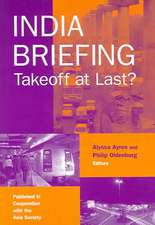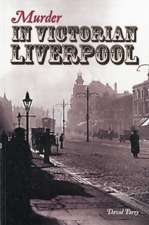Representing Calcutta: Modernity, Nationalism and the Colonial Uncanny: Asia's Transformations/Asia's Great Cities
Autor Swati Chattopadhyayen Limba Engleză Paperback – 15 mar 2006
This book explores the history of the city, focusing in particular on its emergence from colonialism into postcolonial modernity. Drawing on postcolonial and spatial theory, the author analyzes the city under British colonial rule and in its later incarnations, and also examines such issues as gender, identity, and nationalism. It is a an essential text for scholars with an interest in colonialism, South Asia, and urban development.
| Toate formatele și edițiile | Preț | Express |
|---|---|---|
| Paperback (1) | 301.89 lei 6-8 săpt. | |
| Taylor & Francis – 15 mar 2006 | 301.89 lei 6-8 săpt. | |
| Hardback (1) | 769.35 lei 6-8 săpt. | |
| Taylor & Francis – 25 apr 2005 | 769.35 lei 6-8 săpt. |
Preț: 301.89 lei
Preț vechi: 392.67 lei
-23% Nou
Puncte Express: 453
Preț estimativ în valută:
57.77€ • 60.47$ • 47.80£
57.77€ • 60.47$ • 47.80£
Carte tipărită la comandă
Livrare economică 08-22 aprilie
Preluare comenzi: 021 569.72.76
Specificații
ISBN-13: 9780415392167
ISBN-10: 0415392160
Pagini: 330
Dimensiuni: 156 x 234 x 19 mm
Greutate: 0.57 kg
Ediția:1
Editura: Taylor & Francis
Colecția Routledge
Seria Asia's Transformations/Asia's Great Cities
Locul publicării:Oxford, United Kingdom
ISBN-10: 0415392160
Pagini: 330
Dimensiuni: 156 x 234 x 19 mm
Greutate: 0.57 kg
Ediția:1
Editura: Taylor & Francis
Colecția Routledge
Seria Asia's Transformations/Asia's Great Cities
Locul publicării:Oxford, United Kingdom
Public țintă
Postgraduate and UndergraduateNotă biografică
Swati Chattopadhyay is a Professor in the Department of History of Art and Architecture, University of California, Santa Barbara, USA. She is an architect and architectural historian, specializing in modern architecture and the cultural landscape of British colonialism.
Cuprins
Introduction: The City in Historical Imagination 1. The Colonial Uncanny 2. The Limits of White Town 3. Locating Mythic Selves 4. Telling Stories 5. Death in Public. Conclusion: The Politics of Representation
Recenzii
'The author ably juggles racial, gendered, moral, architectural, literary and artistic geographies to craft a highly innovative, scholarly and stylishly executed study ... on a personal note, as the granddaughter of a suburban Calcutta architect I particularly welcome this book.' - Social & Cultural Geography
'Representing Calcutta provides a new and exciting look into the burgeoning capital of the Raj in the early nineteenth century. Chattopadhyay powerfully weaves together architecture, space, and culture to describe a city of 'blurred boundaries', in which British and Bengali each play a part in the creation of a distinctively colonial culture. From the layout of the bungalow to the ideas of Bengali reformers, Chattopadhyay gives us a living Calcutta in place of the usual stereotypes derived from Kipling and contemporary image-making' - Thomas R. Metcalf, Professor of History Emeritus, University of California, Berkley
'Representing Calcutta offers a wide ranging and fluent interpretation of the literature, art, and urban landscape of the colonial city that uses each to illuminate and sometimes to undercut the others. Chattopadhyay's great talent is to lay out large issues in concrete ways, creating a vivid and memorable portrait of colonial Calcutta's life and landscape and offering a fresh perspective on one of the world's great cities.' - Dell Upton, School of Architecture, University of Virginia
'The author ably juggles racial, gendered, moral, architectural, literary and artistic geographies to craft a highly innovative, scholarly and stylishly executed study ... on a personal note, as the granddaughter of a suburban Calcutta architect I particularly welcome this book.' - Social & Cultural Geography
'Representing Calcutta provides a new and exciting look into the burgeoning capital of the Raj in the early nineteenth century. Chattopadhyay powerfully weaves together architecture, space, and culture to describe a city of 'blurred boundaries', in which British and Bengali each play a part in the creation of a distinctively colonial culture. From the layout of the bungalow to the ideas of Bengali reformers, Chattopadhyay gives us a living Calcutta in place of the usual stereotypes derived from Kipling and contemporary image-making' - Thomas R. Metcalf, Professor of History Emeritus, University of California, Berkley
'Representing Calcutta offers a wide ranging and fluent interpretation of the literature, art, and urban landscape of the colonial city that uses each to illuminate and sometimes to undercut the others. Chattopadhyay's great talent is to lay out large issues in concrete ways, creating a vivid and memorable portrait of colonial Calcutta's life and landscape and offering a fresh perspective on one of the world's great cities.' - Dell Upton, School of Architecture, University of Virginia
'The author ably juggles racial, gendered, moral, architectural, literary and artistic geographies to craft a highly innovative, scholarly and stylishly executed study ... on a personal note, as the granddaughter of a suburban Calcutta architect I particularly welcome this book.' - Social & Cultural Geography
Descriere
This major new postcolonial study addresses the questions of modernity and space that haunt our perception of Calcutta. It explores the politics of representation and the cultural changes that occurred in the city as its residents negotiated the idea of being 'modern'.

























